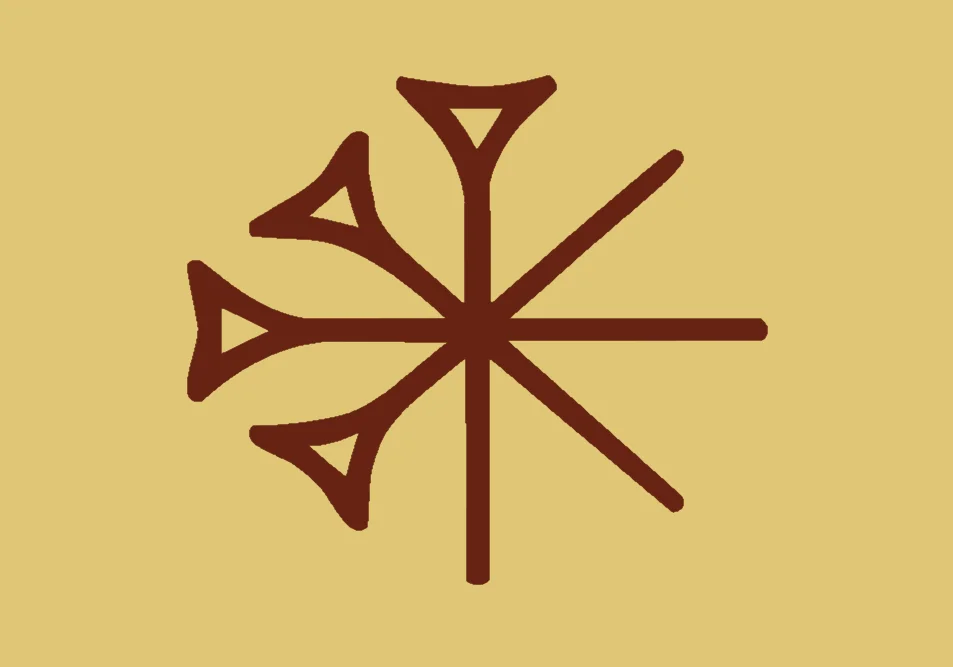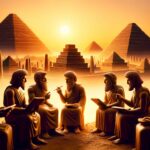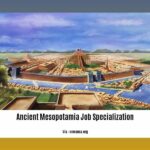Get ready to dive deep into the mysterious world of the Anunnaki, where ancient symbols whisper secrets of a forgotten past. From the mighty horned cap to the graceful winged disk, each symbol tells a part of the Anunnaki’s story—gods, rulers, and, as some believe, the architects of human civilization. Let’s decode these ancient symbols and uncover the mysteries that have puzzled us for ages!
Decoding the Divine: Understanding Anunnaki Symbolism
Deep in the cradle of civilization, Mesopotamia, lived the enigmatic Anunnaki, a group of powerful gods whose stories are etched in stone and clay. Their symbols weren’t mere decorations; they were a complex language, revealing ancient Mesopotamian beliefs about the cosmos, the divine, and the very essence of humanity.
These symbols were like badges of honor, showcasing the Anunnaki’s divine status and connection to the heavens. For instance, the horned cap, a crown worn by these gods in countless depictions, suggests a celestial origin. Their very temples weren’t just places of worship; they were seen as earthly embassies for these celestial beings, demonstrating their influence on the mortal realm. Then there’s the eight-pointed star symbol, often associated with Anu, the king of the sky gods, representing power from above and the grand design of the universe.
Myths and Legends: Anunnaki Symbols in Narrative
Imagine the ancient Sumerians sharing their creation stories. These weren’t just bedtime tales; they explained the world around them. The Anunnaki, adorned with their symbolic language, were major players in these narratives, often portrayed as powerful forces who, some believe, gifted humanity with knowledge and the tools to build civilizations. Their presence in ancient texts and artwork illustrates how deeply they were woven into the fabric of Mesopotamian society.
Examining the symbols of individual gods reveals even more intriguing layers. Take Enki, the god of water and wisdom. He’s frequently depicted with the fish symbol, a likely nod to his mastery over the depths and the life-giving force of water. Then there’s Enlil, the storm god, associated with power and authority – his symbol? The mighty bull, a fitting representation of strength and dominion.
Ancient Symbols, Modern Fascination: The Anunnaki’s Enduring Legacy
It’s remarkable how, even today, Anunnaki symbols continue to fascinate and intrigue. From dusty museum artifacts to modern interpretations, they’re like riddles that historians, scholars, and even pop culture can’t resist trying to solve. Their enduring presence in our collective imagination speaks to the profound impact the Anunnaki have had on human spirituality and the stories we tell ourselves about the universe.
Who is the god of Anunnaki?
It’s easy to assume that a powerful group like the Anunnaki had a single, all-powerful leader. However, the Anunnaki weren’t ruled by a solitary “god” in the way we might typically imagine. Picture them instead as a complex family, with a hierarchy of influential members. While some deities, like Anu, Enlil, and later Marduk, held higher positions of authority, there wasn’t one single figure calling all the shots.
Each Anunnaki deity had specific talents and responsibilities. Some governed the sky, others the earth, and still others ruled over domains like wisdom or the underworld. Each may have even had their own groups of followers who worshipped them in distinct ways.
The notion of a singular “god” of the Anunnaki is a more recent interpretation, often stemming from intriguing, but not necessarily historically accurate, theories about ancient astronauts. These interpretations, while captivating, shouldn’t be confused with the beliefs held by ancient Mesopotamians.
To truly understand the Anunnaki, we need to differentiate between the ancient Mesopotamian worldview and more modern reinterpretations. The Anunnaki were more akin to a divine community, with a complex web of relationships and responsibilities, than a group with one supreme leader. Their story is full of captivating details, and the more we learn, the more we realize how much more there is to discover.
What does Anunnaki mean in English?
The word “Anunnaki” transports us back in time to ancient Sumer, to the heart of Mesopotamia. It’s a word that held great significance in the Sumerian language.
Composed of two parts – “An,” meaning “sky” or “heaven,” and “ki,” meaning “earth” – “Anunnaki” essentially translates to “those of royal blood” or “those who came from heaven to earth.” The name itself evokes a sense of epic descent and divine lineage.
In Sumerian mythology, the Anunnaki were central figures. They were powerful gods and goddesses believed to have descended from the heavens to shape the world and guide humanity.
However, it’s crucial to understand that the Anunnaki weren’t a singular entity but rather a pantheon of gods and goddesses, each with unique personalities, powers, and domains. There was Enki, associated with water and creation; Enlil, who commanded the air, storms, and wind; Inanna, the goddess of love, beauty, and, perhaps surprisingly, war; and the prominent Marduk, who rose to become the king of the gods in Babylonian mythology.
The Anunnaki were ever-present in the lives of ancient Mesopotamians. People worshipped them in grand temples and immortalized their stories through myths and legends that continue to fascinate us today.
In contemporary times, the meaning of “Anunnaki” has taken on new layers of interpretation. Particularly in certain circles, it’s used to refer to extraterrestrial beings – ancient aliens – who may have visited Earth long ago, influencing human development. While an intriguing concept, it’s important to note that these interpretations lack concrete scientific evidence and fall outside of mainstream scholarly understanding.
The word “Anunnaki,” then, takes us on a journey from the depths of ancient Sumerian mythology to modern-day speculation, reminding us of the enduring power of stories and the human fascination with the unknown. As we continue to explore the mysteries of our past, who knows what further discoveries await?
What does Anunnaki mean in Arabic?
The Anunnaki, those powerful deities from ancient Mesopotamian mythology, have captivated imaginations for centuries. But what happens when we try to trace their name, “Anunnaki,” through the lens of the Arabic language? Do we find a direct translation, a clear echo of their ancient legacy?
The truth is, finding a precise equivalent for “Anunnaki” in Arabic is a complex endeavor. Languages evolve over time, cultures interact and blend, and meanings shift like sand dunes in the desert wind. While a simple, one-to-one translation might not exist, that doesn’t mean there’s no connection to be unearthed. It’s more about piecing together a puzzle, exploring the potential for linguistic borrowing, examining scholarly interpretations of ancient texts, and tracing the threads of myths and stories as they travel across cultures.
For example, there may be Arabic words or concepts related to the Anunnaki’s powers or roles in mythology that share a common ancestor with ancient Sumerian. Perhaps Arabic scholars from centuries past studied Mesopotamian tablets, offering their own insights into the Anunnaki. It’s also possible that figures or narratives within Arabic mythology parallel the Anunnaki tales, hinting at a shared wellspring of inspiration.
Think of it this way: imagine a meteor shower illuminating the night sky. Observers from different cultures, with their unique languages and perspectives, would describe the event in distinct ways, each adding their own cultural nuances to the shared experience. The Anunnaki are like that meteor shower – their influence could have spread and been interpreted in diverse ways within the Arabic-speaking world. It’s up to researchers and curious minds to investigate those potential connections, unraveling the intricate tapestry of cultural exchange and linguistic evolution.
While a straightforward answer to “What does Anunnaki mean in Arabic?” might remain elusive for now, the question itself opens up exciting avenues of exploration. It invites us to consider the fascinating interplay between ancient civilizations, the transmission of ideas, and the enduring power of myths to transcend linguistic and cultural boundaries.
What are the symbols of Enki?
Enki, the Mesopotamian god of wisdom, water, and creation, played a pivotal role in ancient beliefs. But how did the Sumerians and Akkadians visually represent this powerful deity? What symbols did they use to convey Enki’s dominion over life-giving waters and his association with knowledge and civilization?
The Fish: A Symbol of Abundance and Life
One of Enki’s most prominent symbols was the fish. This enduring emblem likely connected him to the Apsu, the primordial freshwater abyss from which, according to Mesopotamian belief, all life emerged. But the fish represented more than just Enki’s watery domain; it symbolized fertility, abundance, and the sustenance he provided. Ancient Mesopotamian artwork often depicts Enki surrounded by flowing water or holding a fish, emphasizing his role as a creator deity and a source of life.
The Goat: Embracing Enki’s Wild Side
Perhaps more unexpected is Enki’s association with the goat. Why a goat? In ancient Mesopotamia, goats were symbols of fertility and the untamed power of nature. These creatures were known for their resilience, thriving in the rugged, mountainous regions. They represented a certain wildness, an untamed spirit that mirrored aspects of Enki’s own nature. He wasn’t just about peaceful waters and serene wisdom; he embodied a primal force, a connection to the raw power of the natural world, which the goat symbolized perfectly.
The Enduring Power of Enki’s Symbols
The true significance of Enki’s symbols lies not just in their individual meanings but in their impact on the lives of ancient Mesopotamians. Imagine encountering these symbols everywhere – on cylinder seals, amulets, and even adorning the walls of Enki’s temples. Priests would have worn them as badges of honor, demonstrating their devotion. People believed these symbols brought them closer to Enki, offering protection, blessings, and a connection to his divine power. They were not mere decorations; they were tangible links to a fundamental force in their universe.
Here’s the key takeaway:
- Enki’s symbols, particularly the fish and the goat, weren’t arbitrary choices; they were visual representations of his power over water, his connection to nature’s raw energy, and his role as a bringer of civilization.
- These symbols held deep cultural and religious significance for the ancient Mesopotamians, serving as conduits to Enki’s divine power and blessings.
- Enki’s association with water and fertility elevated him to a position of great importance in ancient Mesopotamian belief. He was seen as a source of life, abundance, and wisdom.
Unveiling the Secrets of Ancient Mythology:
Interested in exploring other captivating figures and symbols from ancient cultures? Discover the intriguing tale of Anansi the spider, the trickster who wove his way into folklore. Delve into the enigmatic Anubis symbol, a powerful representation of the afterlife in ancient Egypt. You can also explore the mysterious Anunnaki compass, believed by some to have guided the enigmatic Anunnaki, and unravel the significance of the Aztec nose, a revered symbol of strength and divinity in Mesoamerican culture.
- Mastering Leader in Spanish: The Complete Guide - April 19, 2025
- Uncovering Surprising Parallels: England Size Compared to US States - April 19, 2025
- Old Mexico Map: Border Shifts 1821-1857 - April 19, 2025
















